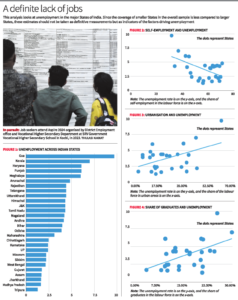Published on: April 11, 2024
UNEMPLOYMENT IN INDIAN STATES
UNEMPLOYMENT IN INDIAN STATES
CONTEXT: Recent report released by the International Labour Organization (ILO) and the Institute for Human Development (IHD) that revealed unemployment status in India. Little is understood about the causes of unemployment in India, a knowledge gap that requires urgent redressal.
A PEAK TO REPORT
- Scope and Focus: The analysis focuses on unemployment in major Indian states, excluding Union Territories, among individuals aged 15 and above.
- Data Source: Utilizes data from the Periodic Labour Force Survey (PLFS) of 2022-23.
- Exclusion of Manipur: Manipur is excluded due to incomplete fieldwork caused by ongoing conflict.
- Sample Size Variation: Acknowledges that smaller states have less representation in the sample compared to larger states, impacting the precision of estimates.
- Interpretation: The estimates provided are not definitive measurements but rather serve as indicators of key factors influencing unemployment trends
AN ANALYSIS OF UNEMPLOYMENT
- Unemployment Rates by State (2022-23):
- Highest: Goa at nearly 10%, more than three times the national average of 3.17%.
- Top 5 States: Goa, Kerala, Haryana, Punjab , Meghalaya
- Regional Trends: Western India’s Maharashtra and Gujarat have lower rates than the national average.
- Regional Disparities:
- Four out of the top five States with high unemployment rates are comparatively richer.
- Most northern and southern States have unemployment rates above the national average, except Karnataka in the south.
- National Average Impact:
- 12 out of 27 States have unemployment rates below the national average.
- Maharashtra, Uttar Pradesh, and Madhya Pradesh have notably low rates, contributing to the lower national average.
- Income and Unemployment Relationship:
- Conundrum: Except for Maharashtra and Gujarat, States with rates below national average often have lower per capita incomes than the national average.
THE DETERMINANTS OF UNEMPLOYMENT
- Self-Employment and Unemployment:
- Figure 2 Analysis: Shows a downward-sloping trend line, indicating a negative relationship between self-employment share and unemployment rates.
- Informal Self-Employment: States with a higher proportion of informal self-employment find it easier to absorb job-seekers, but causality between self-employment and unemployment is unclear.
- Agriculture and Rural Economy:
- Informal Sector Dominance: Much informal self-employment is in agriculture and rural sectors.
- Urban vs. Rural Focus: Examining the urban labor force size provides a proxy; highly urbanized states have lower informal job availability due to smaller agrarian sectors.
- Urbanization and Unemployment:
- Figure 3 Insight: Shows a positive correlation between urban labor force share and unemployment rates.
- Impact on States: Highly urbanized states like Goa and Kerala face higher unemployment due to limited informal job opportunities compared to agrarian-focused states like Uttar Pradesh, Jharkhand, and Madhya Pradesh.
ON EDUCATION AND EMPLOYMENT
Educational Attainment and Unemployment:
- Figure 4 Analysis: Shows a clear positive relationship between the share of graduates in the labor force and unemployment rates across Indian States.
- Example: Kerala, with a highly educated labor force (30% graduates), faces high unemployment; Gujarat and Maharashtra, with lower graduate shares (14% and 20% respectively), have lower unemployment despite being richer and urbanized.
- Possible Explanations:
- Skill Relevance: Graduates may lack skills for the modern sector, emphasizing the need for improved teaching infrastructure and standards.
- Aspirations vs. Opportunities: Graduates seek high-wage jobs matching their skills, contributing to unemployment if the modern sector doesn’t expand enough to absorb them.
- Historical Trends: Graduates historically faced unemployment, even during the early stages of the modern sector.
- Policy Implications:
- Role of State Policy: State policies also influence unemployment rates.
- Structural Transformation: Analysis highlights the link between structural changes like reduced agriculture, increased urbanization, and higher educational attainment with rising unemployment rates.
- Policy Focus: Urges policy to focus on employment generation to counteract rising unemployment trends.

